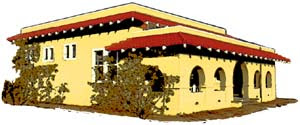Former Nevada Lt. Gov. and Western actor Rex Bell
By Jeff Mosier
Las Vegas Review-Journal
Without historians, the Declaration of Independence is just a piece of paper. The Mona Lisa is a woman's portrait. The Rosetta Stone, a stone. Historians give these artifacts meaning we can understand.
Students at the University of Nevada, Las Vegas, 4505 S. Maryland Parkway, are doing the same thing closer to home. About 25 graduate students in the public history program of the UNLV History Department spent much of the past semester at the Walking Box Ranch in Searchlight, cataloging and cleaning thousands of artifacts.
The ranch was once home to former Nevada Lt. Gov. and Western actor Rex Bell and his wife, actress Clara Bow. It is being restored to serve as a museum and desert research facility.
The students were led by U.S. history professor Deirdre Clemente. The public history program, as she puts it, is for "students to experience alternative careers you can do with a history degree outside of classroom teaching."
That is especially important since jobs within academia are drying up, she said.
"The degree prepares students to do all kinds of things," Clemente said,. "from curating exhibitions to participating as a consultant for government agencies. They know about the cultural landscape of areas and how to navigate it. There are dynamic careers out there for historians."
Margaret Huettl, a 24-year-old working toward a doctorate, wants to study Native American communities and become a university professor. She spent months working with a collection of Navajo rugs from the 1930s.
"My partner and I were trying to put together a plan to display and preserve the rugs," she said. "We looked at the cultural context and what the rugs meant to the people who made them and bought them.
"It's been a really good experience. It gives you the chance to apply what you're learning in the classroom in the real world. You start to understand things in a totally different way. It was perfect."
That kind of intimacy could not be replicated in a classroom setting, Clemente said.
"You're using objects or material to teach," Clemente said. "They are project-based classes. We expose them to different sources and use oral and visual history."
Students worked on the ongoing project with the Public Lands Institute and Preserve Nevada. The ranch is owned by the Bureau of Land Management, and Clemente said it had fallen into "disrepair" before the project started.
Another student, Mike Bennion, took a less conventional route into the program.
Bennion worked in retail and sales management for 30 years before being laid off three years ago. At 57, he is finally pursuing his dream.
"I looked around for things to do, and I had an interest in U.S. history," Bennion said. "I see it as an intersection of things I like to do.
"My appetite got stirred up at a pretty early age. I've traveled the U.S. several times trying to visit all the places I read about."
Bennion made about a dozen trips this semester cataloging more than 400 ranching objects from the 1940s donated to UNLV by Rex Bell Jr.
"There's really no substitute for putting your actual hands on history," Bennion said.
"You're talking about a ranch. You go out and feel the wood on the corrals. You're picking things up and trying to figure out the best way to mark them without damaging them. You're reading accounts about people using the things. You're pulling everything together. ... The smells are missing, but at least you can describe them to a degree.
"It's exciting to be able to take oral history and the place and time and tie those things together to tell a story that would be compelling to a non-academic audience."
Clemente's spring semester class will focus on the history of fashion in Las Vegas and the West. She expects the class to culminate with a student-curated exhibition called "Vegas Style."
Bennion has a semester left before he will get a master's degree but said his time at the ranch already has opened some options for work.
"It was a real rich experience," Bennion said. "I remember one day actually cleaning the shower floor in Clara Bow's bedroom. Academics takes you to places you wouldn't have access to otherwise. It's a different feeling, one I've learned to appreciate."





